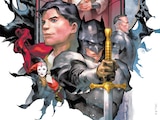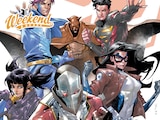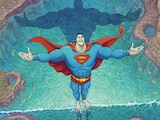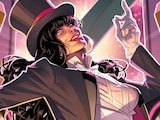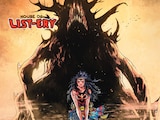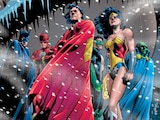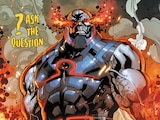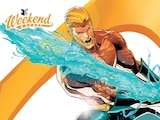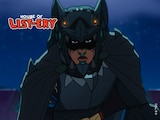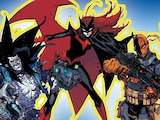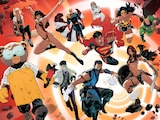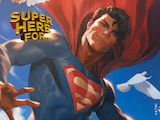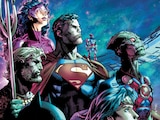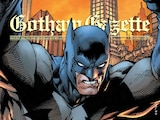
The Jim Lee Interview
If you’re reading this, congrats! You decoded the secret URL hidden inside Direct Currents #1! (Or you followed a link from someone else who discovered the URL. Which is less impressive, and only worth half the points.)
Regardless, your reward for landing on this page is an exclusive interview with DC Comics Co-Publisher Jim Lee. The superstar artist took a break from the drawing board and the boardroom to discuss Warren Ellis’ return to WildStorm, the Suicide Squad squaring off against the Justice League and what’s coming next for DC’s Rebirth…
DIRECT CURRENTS: Jim, you founded WildStorm almost 25 years ago, and now it’s returning as a pop-up imprint in February at DC. Why is this the right time to bring back these characters and concepts?
JIM LEE: When we launched the New 52, the WildStorm characters and franchises were a big part of that. Some conclusions or themes came out of that combination: it’s difficult for some of the WildStorm concepts to really shine in a universe where Superman and Batman exist. The WildStorm characters were created in a very different type of environment: set in the ’90s, a world of government conspiracies, things living in the shadows…they were fighting an illuminati-type of foe. And the DC Universe, at its core, is very different.
DC: Many of the WildStorm characters showed up in the New 52, but some seemed to struggle fitting in to the broad DC Universe.
LEE: I think it was interesting and maybe a challenge for creators to incorporate the two and have it be a nice, clean fit. But as we started to think about rebooting the WildStorm Universe, keeping these leanings in mind, we realized it would be best for these characters to live on their own in a separate universe. When we moved forward, we wanted to do it with someone who got the conceits behind the characters but could also give us a tonality that was consistent across the universe.
 DC: Did making this a pop-up imprint and bringing back Warren Ellis, who told some of the most memorable WildStorm stories, help focus this?
DC: Did making this a pop-up imprint and bringing back Warren Ellis, who told some of the most memorable WildStorm stories, help focus this?
LEE: That was another thing that was nice about the WildStorm Universe when we first launched it—it was a small number of books. You got into it. It felt consistent. It felt like a world where you saw characters come on the stage. It felt very tight and neatly plotted. We needed the right creator, the right format, the right smaller scope in terms of number of titles. I’d been pestering Warren Ellis to do something with the characters for years, and I finally broke through. He agreed to do this. When people think about the WildStorm stories, there are a lot of great runs, but certainly his run on AUTHORITY, STORMWATCH and all the stories he told in the WildStorm Universe were some of the very best stuff we published. Having him on board as the principal creative engine—writing the first-launch book called THE WILDSTORM—and curating and overseeing the books that will be slowly added to the line, it’s a no-brainer. This is exactly what we need.
DC: So is this a return to the classic WildStorm people remember?
LEE: If you look at the material and the covers, Warren’s not one to repeat himself. He’s taking the original WildStorm Universe and reimagining it in a way only he can. It’s something that’s recognizable and still very fresh and contemporary. I’ll be frank, there’s a bit of controversy over “what is this exactly?” If you look at the cover, it’s not your typical superhero slugfest cover. It’s muted in color. It’s subdued in its poses. It could easily be an album cover. But there is that sense of mystery. What is behind this? That’s the core of what he’s introducing: there’s a bigger story that he’ll slowly unveil through these different titles. He’s enjoying taking known elements and reinventing them and surprising the reader with essentially a new symphony that he’s orchestrating. It’s going to be interesting, surprising and exciting.
DC: The interior art is also very different from what we’ve previously seen in the WildStorm books.
LEE: Jon Davis-Hunt comes over from Vertigo’s THE CLEAN ROOM. When we talked to Warren about the aesthetics of it all, he definitely wanted to go with something that didn’t feel like a holdover from the ’90s. You know, someone like me, which is perfectly cool and I applaud him, because this is what we wanted. We don’t have the benefits of having been around 75 years or a generation of readers. For a lot of the readers, these are unknown characters. But at the same time, you have a small hardcore group that really loves these characters. So how do you satisfy both groups? Warren is challenging Jon to deliver something that is superheroic but redefined. That’s the approach they’re taking with the coloring, the line art, the expressions, the body language. But at the same time, Jon is doing some of the widescreen stuff Warren is known for with the thin, wide panels. I think they’re really challenging each other to reinvent the modern-day superhero wheel. WildStorm and WildC.A.T.S., in its day, were attempting to do that. They’re taking that central conceit—if there were superheroes today, what would they look like? How would the stories be told? What would be their core motivations? It’s very much a modern story and the art reflects that.
 DC: One of your numerous duties here at DC is drawing the twice-monthly SUICIDE SQUAD title. Why is now the time to have that team of villains face off with the Justice League?
DC: One of your numerous duties here at DC is drawing the twice-monthly SUICIDE SQUAD title. Why is now the time to have that team of villains face off with the Justice League?
LEE: It’s really a coming of age for the Suicide Squad. The concept’s been around awhile, but it’s never had the legs or the fan base of something like the Justice League. With the success of the movie and the rise of the antihero in more recent years, it’s a concept that was really ahead of its time. People get it now and see the challenges of having a superhero team made up of villains. Is an enemy of your enemy a friend? It raises a lot of very modern political questions and challenges. And you juxtapose them against the Justice League, who are characters that have been around for 75-plus years, built on this notion that together we are undefeatable, together we can achieve more than we achieve on our own. So it’s not a clash of superheroes or superpowers, but really a clash of themes and the core concepts of these two teams. That’s just something we haven’t done before with these franchises. It makes for a lot of fun storytelling. That creative opportunity is really what’s driving a big event like this.
DC: Are we going to see more of these events as Rebirth evolves?
LEE: After being co-publisher now for six years, what’s interesting is, between the New 52 and Rebirth, we’re starting to see these über-narratives develop. It’s no longer just about monthly storylines. If we look at the building blocks of what we’re creating, it’s the monthly comics, then the epic events that tie in storylines over a period of three to six months, or maybe even a year. But then we start to see how New 52 and DC YOU and Rebirth are mega thematic narratives that are being generated. We’re now starting to talk about what we follow up Rebirth with. How do we take the core concepts of Rebirth and continue to push that forward? It’s interesting to be able to look at that from 35,000 feet up and then start understanding that it’s not about a quarterly event or an event every six months, but a bigger storyline that we’re generating as a publishing entity.
 DC: And some of this will be directly tied to what happened in DC UNIVERSE: REBIRTH #1…
DC: And some of this will be directly tied to what happened in DC UNIVERSE: REBIRTH #1…
LEE: We’re going to take the success of what Geoff Johns and artists Gary Frank, Ethan Van Sciver, Ivan Reis and Phil Jimenez created in the Rebirth special—you’ve already seen that drive a lot of the Rebirth line—and see the ramifications of that special edition on the rest of the line. The first year is about establishing who these characters are, deconstructing them down to their core essence, to what makes them unique and special, and doing stories with the best elements of those mythologies, then following that up with diverse and different teams clashing and seeing how that impacts the universe. What follows are the ramifications of what happened in that Rebirth special.
DC: And this isn’t just about events—is it about giving readers new and interesting stories that surprise them?
LEE: Now that we’ve done New 52, DC YOU and Rebirth, what can we do with the characters that hasn’t been done before? That’s a huge question, especially when you’ve been publishing for 75-plus years. We have some amazing things planned for the Justice League, Batman, Superman and Wonder Woman that haven’t been done before. I don’t want to give too much away, but—in the same way New 52 and Rebirth took things you might have always known and reinvented them, or introduced new things that felt like they’d been there forever—what we’re planning for 2017 will introduce new concepts that feel like they’ve always been there but have never been fully exploited. That might sound vague, but it’s as specific as I can get. I think people will see some stuff and go, “Wow, of course, that makes a lot of sense. Why has that never been done before?” It’s cool stuff that gets us excited.

